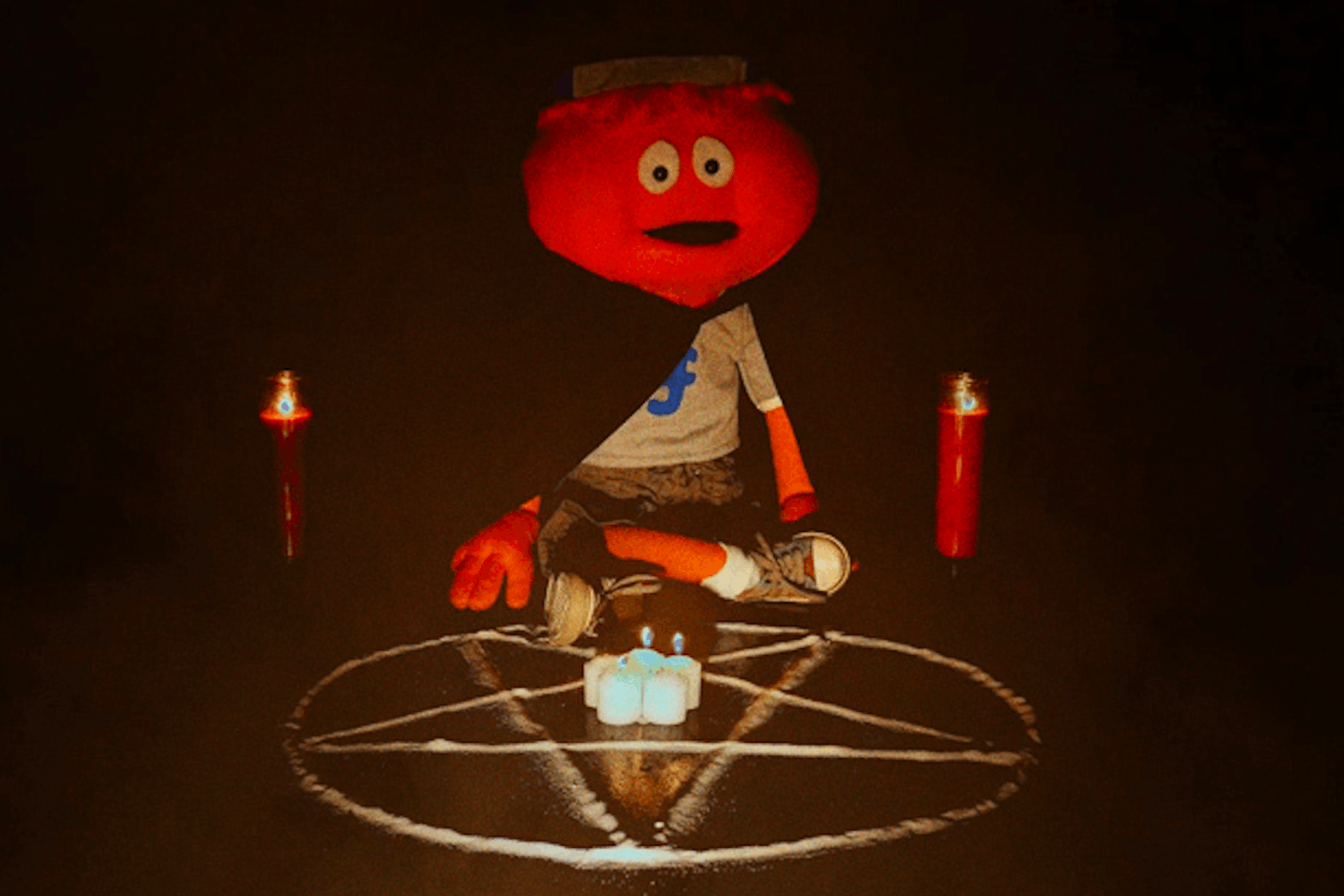The Great Satan is a horror experience that transcends traditional genre labels. Without having seen it – without being indoctrinated into the found footage collective Everything is Terrible! (EIT!) – the film itself might be difficult to comprehend. But The Great Satan is at once experimental and narrative, hilarious and terrifying, body horror and evangelical singing duck video.
“It wasn’t a film that was to be enjoyed; it was an indoctrination into the occult,” says an ominous voice near the end of the film’s 72-minute runtime. And it’s true: directors Lehr Beidelschies, Dimitri Simakis, and Nic Maier compiled and recontextualized hours of recovered VHS footage in a disturbing retelling of creation myths, the ideology of the Satanic Panic, and how Satan’s power will conquer all.
Become a Free Member on Patreon to Receive Our Weekly Newsletter
Before EIT! created The Great Satan, there was Doggiewoggiez! Poochiewoochiez!, a remake of Alejandro Jodorowsky’s 1973 surrealist masterwork The Holy Mountain, composed entirely of dog videos. Since then, they have created The Jerry Maguire Pyramid Project, a $500,000 proposal to build a pyramid monument out of all the Jerry Maguire VHS tapes – all of them, stacked in the desert for all time.
In 2018, EIT! released The Great Satan as a touring show, including a live performance with the screening of the film. The tour lasted two months and 48 shows, crossing the United States to play small arthouse theaters. The Great Satan premiered as less of a stand-alone film and more as a collective horror experience.
While not a traditional narrative horror, The Great Satan uses its psychedelic collage of clips to create a ‘soft’ narrative. At times, it retells Bible stories; at others, it uses constant juxtaposition to play on darker American Christian fears. The real horror of the film stems less from the constant use of campy VHS horror gore and more from the violent and delusional fears being spewed by the god-fearing people featured in the clips. “If you listen to heavy metal music, the devil will make you kill your mom,” shouts an angry evangelical pastor during the sex, drugs, and rock and roll section of the film.
Although self-described as a found footage project, the crew at EIT! completely upend the meaning of the term. Instead of fictional found footage, the film is built on horrifying – and often comical – actual found footage. And so, the story becomes how that found footage is recontextualized. There are clips from Christian self-help videos, VHS-era horror, Sunday school lessons, and, of course, the masterpiece Jerry Maguire. “I didn’t shoplift the pootie,” asserts a disheveled Tom Cruise in a distorted scene from the film. It is the compilation of these mediums – clips, sound bites, and Jerry Maguire – that form the film's thematic ideas.
Juxtaposition becomes one of the main layers of communication for the filmmakers. The sounds of a children’s choir singing “do not worry about tomorrow / tomorrow will worry about itself” while a polar bear drifts away on an iceberg is one of the more striking thematic combos the filmmakers present.
The overlaying and warped blend of these contradictory images does something more than simply juxtapose uncontextualized clips. Soon, there emerges a layer of subliminal horror. To watch The Great Satan is to feel utterly convinced that you are being brainwashed. It is the nature of how the images are compiled and enmeshed that makes it feel like you are constantly missing the darker, hidden messages. Akin to the flashes of the demon Pazuzu in The Exorcist, The Great Satan uses similar edits during awkward children’s television clips to create an uneasy atmosphere within even the most benign moments in the film.
The filmmakers have taken the idea of found footage like The Blair Witch Project and made it something very different. They have removed the fictional group of kids dying in the woods and the narrative of their lost footage. The Great Satan is found footage on the larger scale of popular culture. Instead of watching the social breakdown of the friend group of Heather, Mike, and Josh in Blair Witch, The Great Satan presents the social breakdown within popular culture. It shows the fear-mongering of the Satanic Panic and the demonizing of kids who wear black – Dungeons & Dragons is vilified, Wicca is a paganistic sin, and loud music is occult.
It is fitting that the title of the film “Great Satan” has also been coined as a 1980s derogatory epithet for the United States from Middle Eastern Countries. The film reflects the seething terror machine that is the 80s American evangelical political game. A churning whirlpool of fear and demagoguery with a focus on the way Satan was seeping into American life when most of the toxicity was coming from the fear itself.
The Great Satan is sometimes undefinable, and yet it grounds itself in the world of horror. Like in so many horror narratives before it, The Great Satan’s greatest horror isn’t the monsters but that classic human demagoguery targeted at the outsider. The Great Satan is a celebration of the weird, the gory, and the terrifically silly while being a condemnation of the fire-branding fanatic hotheads who seek to snuff out such celebrations.
So, the film straddles the line between horror and comedy, but those two genres often coincide. They are both tension genres built around setting up expectations, holding us on the brink, and breaking the tension in opposite directions. They are so similar in method that the blend of genres feels natural. Both force an audience to look at the contradictions of the status quo, painting a hyperbolic yet prescient picture.
The Great Satan uses its genre-bending to the fullest while relishing in a joyful removal of context. It constantly forces you to ask, “What the holy hell is this random insanity?” and “What the everloving heck could the context possibly be?” Sometimes, we may never know, but that is the nature of great texts. We will be analyzing the nuance and intricacies of The Great Satan for decades to come. There is no modern horror experience more ripe for exegesis than the film that includes the line, “I don’t like to hear the squealing of animals in the cemetery when they do their rituals, but they give me free vodka.”







